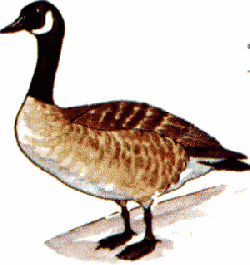
ADAPTATIONS
- webbed feet for swimming
- legs are set forward, so geese are able to walk better on land than ducks and swans
- fluffy down feathers help to protect geese from the cold
- oil glands (near the tail) are used for waterproofing the feathers
- form flocks to fly south for the winter
- might not migrate if there are open waters and a food supply for winter
- found in cities (where there is water and food nearby)

honk (27Kb wav)
BEHAVIOR (HABITS)
- eat by grazing on grasslands or fields; or dipping and dabbling in water
graze : to walk about eating grass and plants
dip and dabble : put head underwater and come out again, splash around
- fly in a v formation
- have different sounds to communicate (about 13 different calls)
honk (when flying), cluck or cackle (when feeding), hiss (when angry)
- also communicate by body movements
- mate for life; pair stays together as long as both are alive and well
|



